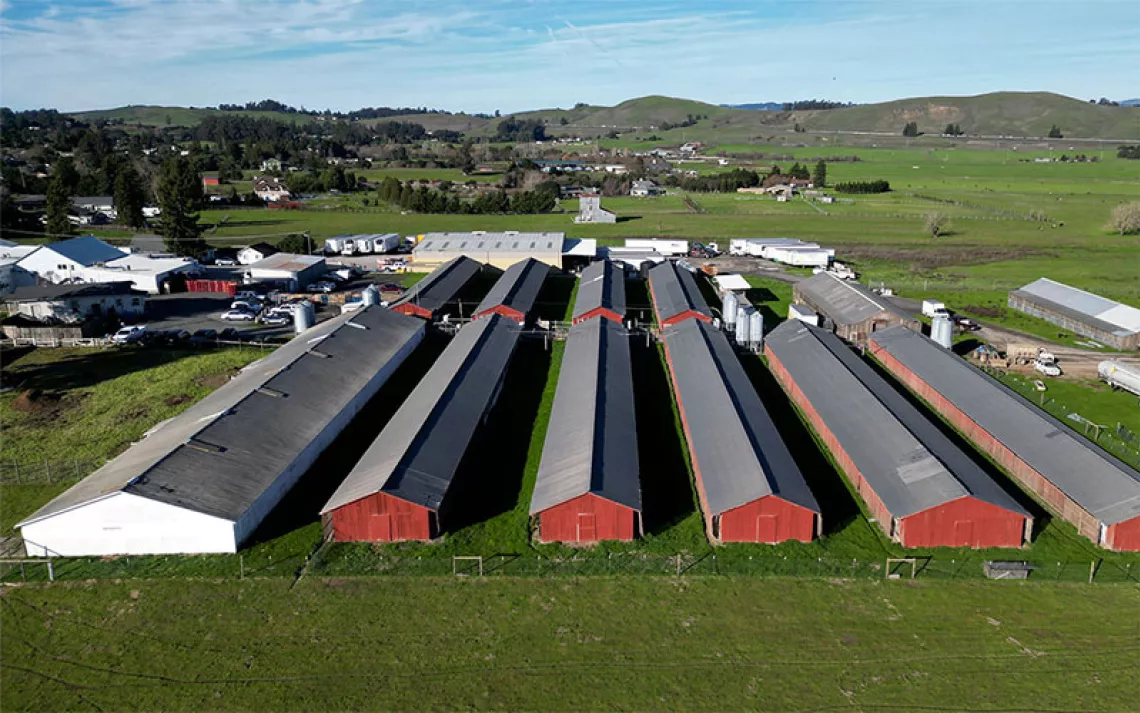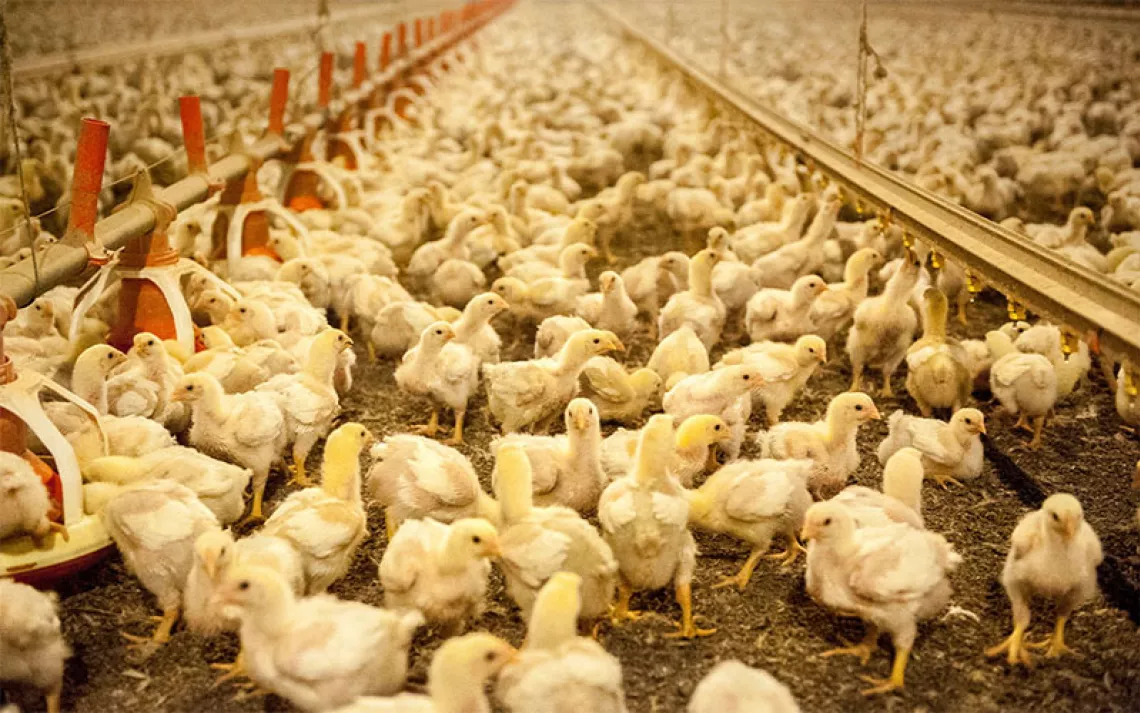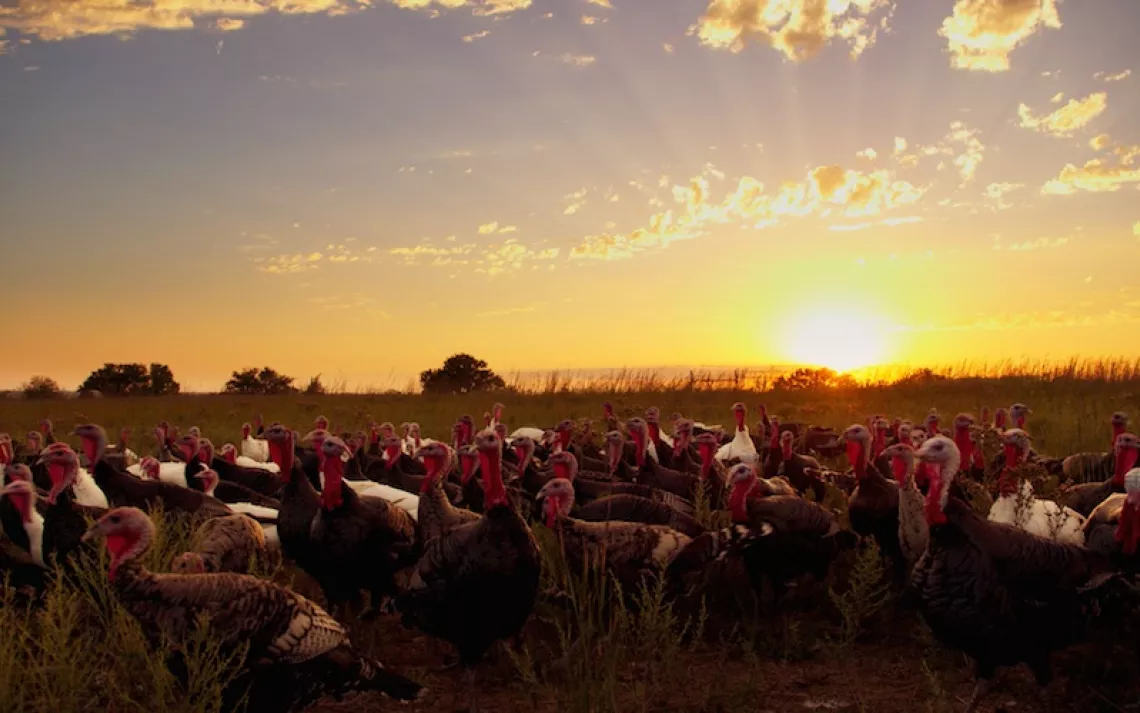The CAFO Industry's Impact on the Environment and Public Health
CAFO farming is an environmental and public health disaster
Photos by Lia Barrett
Duplin County was as flat and lush as I'd imagined. Beneath a blue-dome sky, creeks carved loamy soil as they branched to meet wide rivers. On the narrow North Carolina backroads, we passed homes with shaded front porches and barns built tall for drying tobacco, which along with rice and cotton used to blanket this rich earth.
Then the long, prefab white barns came into view.
They appeared in rows, five and 10 at a time, each one outfitted with several large fans on either end. Looking from a distance, you'd never know that inside every barn there are as many as 750 hogs, jammed into pens and fed and watered by machine. Their waste is funneled to huge pits, or lagoons, some of which are longer and wider than a football field. When they are just over four months old, the hogs are trucked down the road to the largest pork-processing plant on the planet and then shipped all over the world.
Kemp Burdette punched GPS coordinates into his Garmin and veered onto yet another country road. A handsome navy vet and former Fulbright Scholar from nearby Wilmington, he is the Cape Fear riverkeeper for Waterkeeper Alliance. It's his job to document waste violations related to these hog barns, which are known in common parlance as concentrated animal feeding operations, or CAFOs.
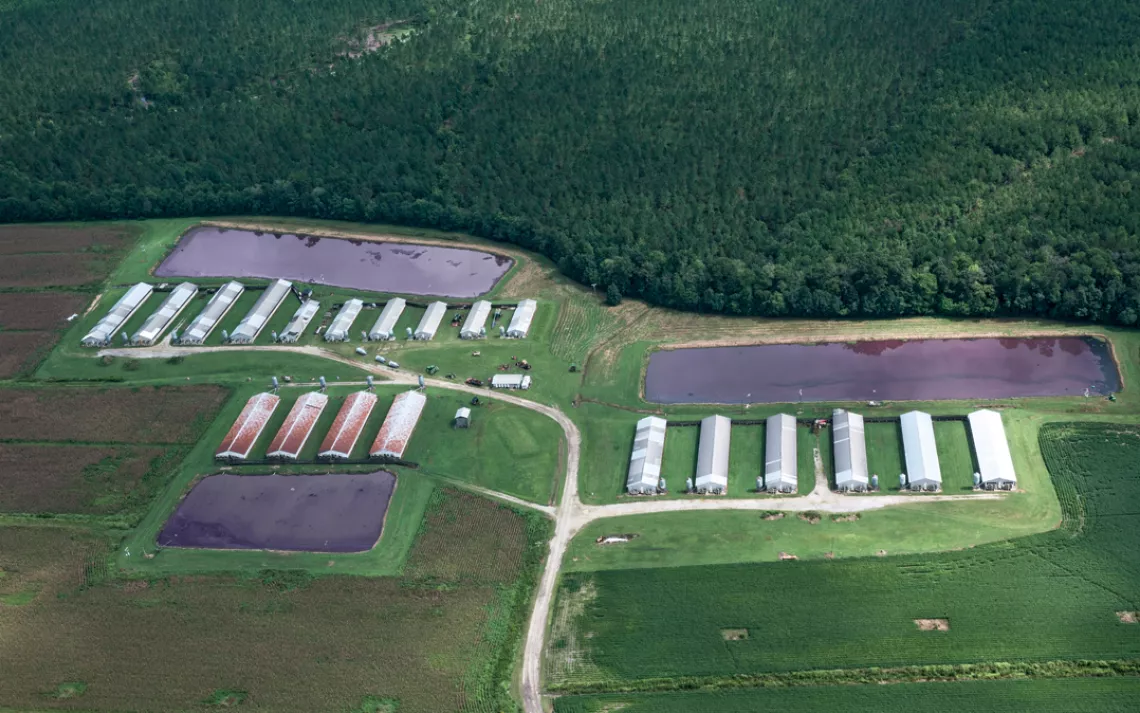
Pig waste is stored in huge lagoons like these, some bigger than a football field, in eastern North Carolina.
Burdette pulled into the driveway leading up to one of them and pointed at an open black dumpster near the road. "That's a dead box," he said. It was empty. "Sometimes it's overflowing with dead piglets." When a pig dies, it is dumped into one of these boxes to get picked up and trucked to a rendering plant. That can take days. Meanwhile, the carcass sits there, blood leaking to the ground while buzzards feast. If the pig died of a virus, that's a problem. Diseases can decimate the entire stock and are sometimes passed along to people living in the area.
As we backed onto the road, a farmer pulled up in a white utility truck. "Shit," Burdette said as he drove away. "This guy is gonna roll up on us pretty quick." Sure enough, the farmer hovered just off our tailgate, which sported a RVRKPR license plate in prominent view. Burdette's eyes darted from the Garmin to the rearview mirror. The truck was gone by the time we turned onto Ed Dale Road.
We stopped for a moment to catch our breath. From the road, we had clear views onto shimmering pink pools of hog waste set behind a collection of CAFO barns.
Lagoons like these are critical to local CAFO operations—and a major environmental hazard. The average pig produces up to 10 times the amount of fecal waste as the average human. When the lagoon level gets near the brim, the waste is sprayed onto nearby fields of undeveloped land, which are sometimes planted with cover crops that can metabolize the waste. If waste is sprayed too often, it saturates the soil and leaks into the aquifer and nearby rivers and streams. The practice also aerosolizes fecal matter, creating toxic particulates that get blown onto nearby homes, accompanied by a terrible stench that drives residents indoors. A majority of those homes belong to African Americans, who have had their property drenched in hog waste for decades and their wells polluted, too. For 30 years, their complaints about the effect on their health and quality of life have mostly fallen on deaf ears at the statehouse—making this a clear case of environmental racism with quantifiable human cost.
CAFO farms are typically located near a body of water. When storms strafe the region, hog lagoons flood, draining waste into creeks, swamps, and rivers. Just this past October, monitors found 10 hog facilities underwater and tallied 15 failed waste lagoons in the aftermath of Hurricane Matthew.
"Over and over, the industry calls this a treatment facility," Burdette said, looking at the lagoons. "It isn't. It's a cesspool."
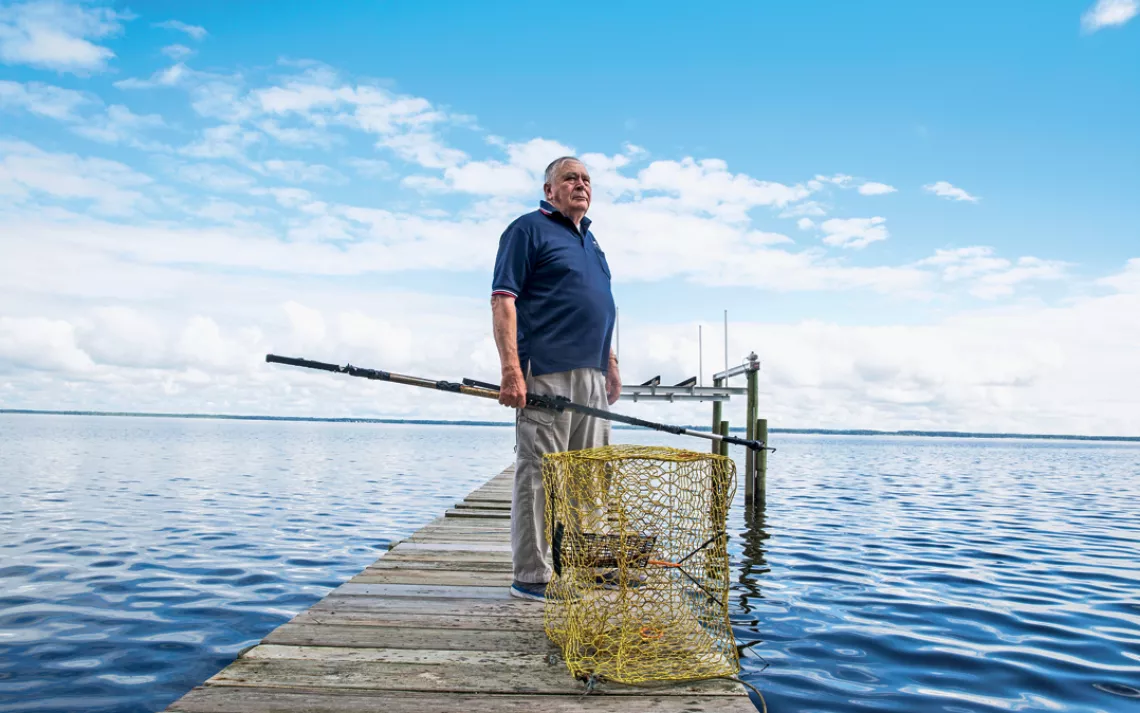
Rick Dove on the dock behind his house near the Neuse River
We weren't back on the road for more than 30 seconds before another truck pulled up behind us. "Dammit. That's Ed Dale," Burdette said. Dale is one of the most outspoken hog farmers in the area and an ardent enemy of Waterkeeper. The word was out. It was time to get off the backroads. But as we turned onto Highway 41, we could see the first truck idling in wait. Now two vehicles were following us. Soon, a third joined the party, and what at first had seemed curious now felt dangerous.
Intimidation has long been a political tactic used to maintain the status quo in the South, and in the Jim Crow days such confrontations often led to violence. Earlier that morning, I'd heard a story of a hog farmer who'd recently threatened a local environmentalist with a rifle in one hand and a pistol at the ready.
Burdette pulled into a crowded parking lot and left me to face an angry Cindy Dale, Ed's wife, who had been driving the third vehicle. "Stay off our property," she said, glaring toward Burdette in the distance. Then she turned to me. "And stay out of Duplin County! You're not welcome here!"
Farmers like these aren't responsible for creating the nation's CAFO industry, which produces well over half of the meat in the United States. They're here to earn a living, and get nervous when environmentalists monitor their facilities because any raised flags could affect their livelihood. It just so happens that what they're protecting is one of the most destructive agricultural practices invented in modern times—a form of industrial meat processing that has led to enormous environmental damage and a public health disaster.
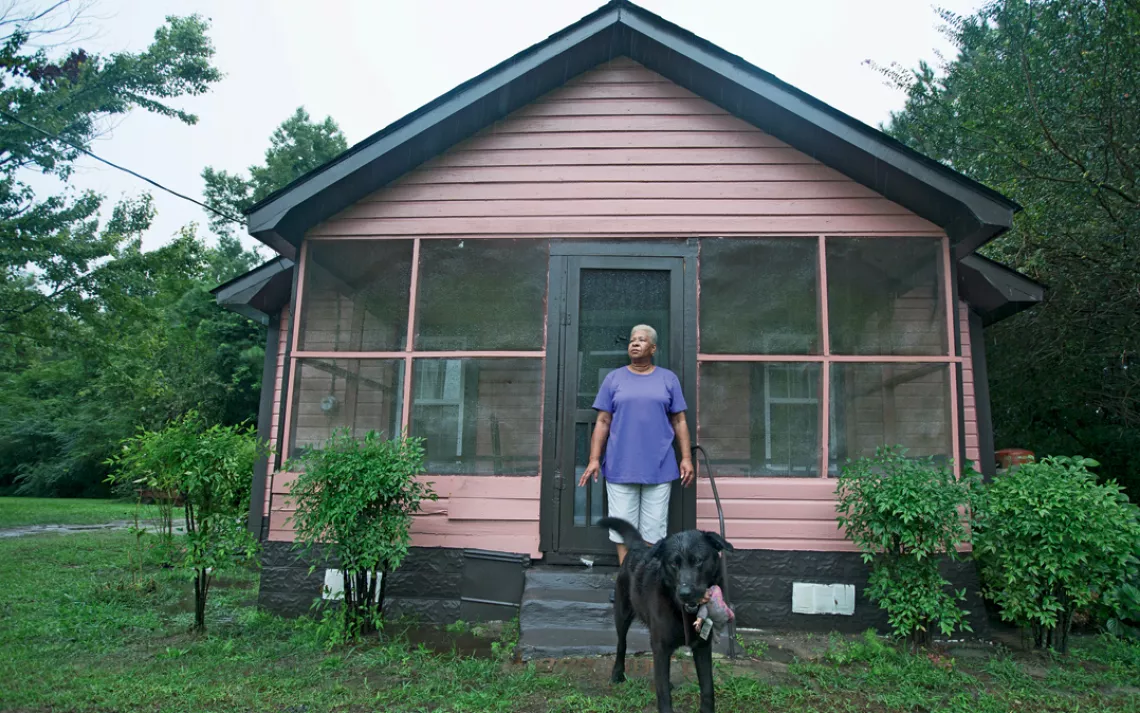
Elsie Herring, one of the participants in the Duplin Health Awareness Project
♦
Thirty years ago, there were 22,000 farmers in North Carolina raising 2 million pigs. Most of those were pasture raised, in a state where whole-hog barbecue is sacred. Now, thanks to an industrial takeover that took root in the 1970s and '80s, there are just over 2,300 farmers raising over 9 million hogs, with 2.3 million in Duplin County alone. Many of those farmers are contract growers working for corporate food companies.
WH Group, a Chinese corporation, became the dominant player here after acquiring the U.K.-owned Smithfield Foods in 2013. Smithfield was the world's largest hog producer, with plants throughout North Carolina employing thousands of residents. WH Group now owns the hogs and supplies the feed. Meanwhile, contract growers are responsible not only for raising the pigs but also for investing the most capital in the operation—where the margins are small—and assuming debts for construction and all of the liabilities for waste disposal. That's why growers feel squeezed when environmentalists snoop around.
Why would farmers be willing to take on all the debt and liability while working for thin profit margins on behalf of an out-of-state—or, in the case of WH Group, out-of-country—corporation? The answer dates back to the late 1970s, when the tobacco market crashed and the local economy needed a boost. Contract farmers were willing to go into debt to build the necessary structures and lagoons for CAFO farms because their contracts guaranteed a certain level of income and insulated them from the fluctuations of the commodities market. Or so they thought. Duplin County had always been an agriculture county, so farmers didn't need any permits or permission to build out and start raising hogs.
The industry was the brainchild of a local man named Wendell Murphy, who owned Murphy Family Farms. He'd studied the poultry industry—which had switched to the CAFO method and become vertically integrated in the '60s and '70s—and wanted to do the same thing with hogs. Murphy, who was elected to the state legislature in 1983 and became a state senator in 1988, was in a prime position to pass laws that would stimulate the industry's growth and derail any environmental legislation that might hold it back.
That led to a series of state subsidies benefiting not individual family farmers but CAFO contract growers. In 1986, Murphy helped pass a bill that eliminated the sales tax on hog and poultry houses; in 1987, the sales tax was waived on any equipment related to the CAFO industry. In 1991, county managers from four of the state's largest hog counties considered imposing regulations on the hog industry. Instead, Murphy cosponsored a bill that prohibited them from passing such zoning ordinances. When the bill passed, CAFO facilities were protected like traditional family farms.
Meanwhile, the practice's devastating impact on local wildlife was becoming increasingly clear.
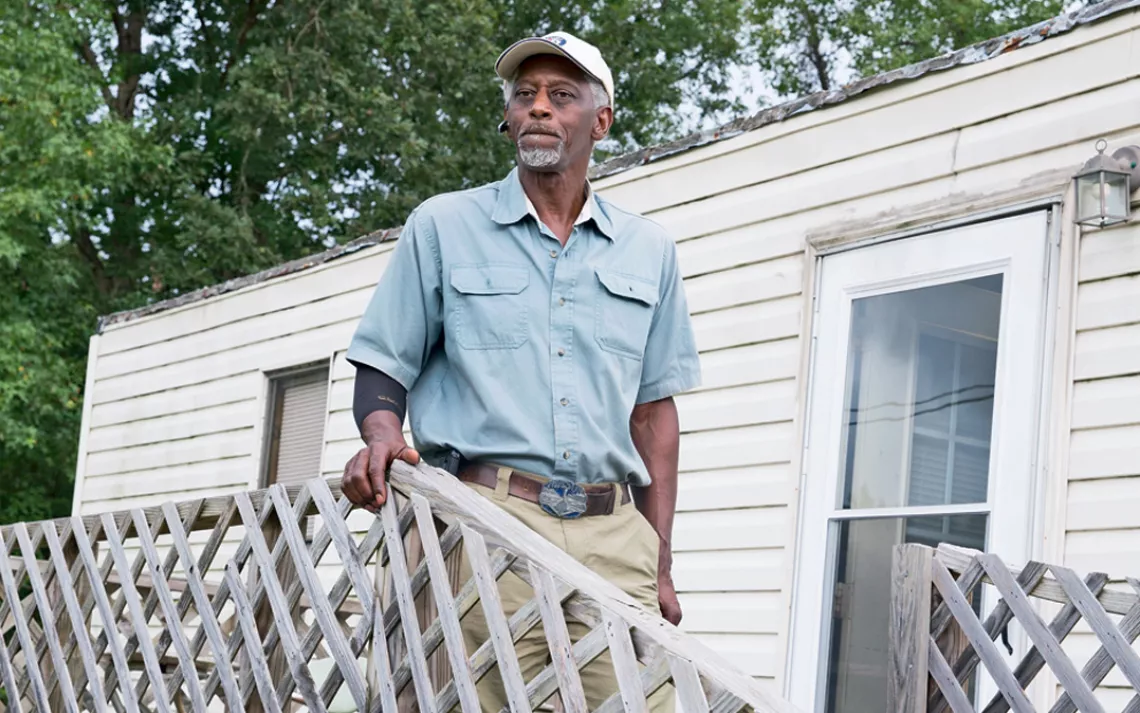
Devon Hall at REACH headquarters
In the late 1980s, Rick Dove, a Vietnam vet and former JAG prosecutor and judge, retired to become a full-time fisherman. He opened a fish market in Havelock, where he planned to sell the fresh catch he and his son harvested on their beloved Neuse River. But the fish they caught often had boils. Then the Doves developed symptoms of their own, including sores on their skin and bouts of memory loss. In 1990, over 2 million fish surfaced dead on the river between August and October. By 1991, the Doves were out of business.
So Dove found another job—as the first Neuse riverkeeper. Through his and his colleagues' investigative efforts, and the work of university scientists, he helped tie the fish kills he'd witnessed and the symptoms he'd suffered to pfiesteria, a tiny one-cell organism. "You can fit 10,000 of them on a head of a pin," he said. "It comes from too many nutrients being in the water." Nutrients, in this case, meant nitrogen, phosphorus, and ammonia, which are found at high levels in hog waste.
More than just surface water was being polluted. Scientists collected evidence that in some cases groundwater had also been contaminated. Many residents were told not to use their wells anymore.
Then in 1995, a dike surrounding a hog-farm lagoon collapsed and sent over 20 million gallons of untreated hog waste barreling into the New River. It was the nightmare scenario people like Rick Dove had long feared.
With the situation spiraling out of control, a deal was brokered. The state Department of Environment and Natural Resources (now the Department of Environmental Quality, or DEQ) would regulate the industry, issue permits to existing CAFO farms, and enforce a 10-year moratorium on future hog CAFOs. But there was no language in the bill requiring the industry to update its waste technology.
Meanwhile, Murphy Family Farms had become a behemoth. By 1997, Wendell Murphy was on the Forbes list with a net worth of a billion dollars. In 2000, he sold his operation to Smithfield Foods, and the multinational corporate takeover of eastern North Carolina's rural economy was complete.
♦
Enter Devon Hall. When he cofounded REACH (Rural Empowerment Association for Community Help) in 2002, Hall was just another Duplin County citizen tolerating CAFOs. REACH was supposed to be a community empowerment organization, not a political advocacy group. Then he met Steve Wing, a public health professor and noted researcher from the University of North Carolina. Wing wanted to set up air-quality-monitoring equipment in neighborhoods within a mile of CAFOs to measure toxins and particulates in the air.
Hall set up the equipment and asked residents to fill out a journal in the morning and in the evening. "There's more activity at the CAFOs around sunrise and sunset," Hall said. "Usually they're flushing out the waste first thing in the morning." Residents were instructed to sit outside and note the intensity of the odor as well as their daily stress and activity levels and use medical equipment to monitor their blood pressure and lung function.
Hall and Wing's collaboration, the first of 10 studies they'd work on together, became the Duplin Health Awareness Project. It included a resident adviser group that met at local churches, community buildings, or the REACH office—a double-wide trailer set on a patch of grass. That's where I met Hall, and as we talked, I could smell hog waste in the air. "That first year, we heard a lot of anger," he said.
Elsie Herring, 68, was one of the residents in the study. Her property is surrounded by CAFO facilities and spray fields. "It stinks," she said. "[Hog waste] comes over here just like it's raining. That's what we inhale if we're outside, and it comes inside the house because you can't keep that odor out."
"We don't have cookouts or family get-togethers like we used to," her niece and neighbor Jessie Mae Brinson said. "Because we don't know when the odor is gonna come. When it's really hot, it burns your eyes."
The odor is an easy target, but what it signifies is worse. Over the years, Hall and Wing were able to prove correlations between hog waste and asthma and other respiratory problems, such as bronchitis, along with compromised immune systems and increased stress and anxiety (Wing passed away on November 9, 2016).
Hall's work didn't stop with air-quality tests. He began taking water samples in collaboration with Waterkeeper, which by then had developed an army of riverkeepers monitoring the industry with a keen eye. They started to map CAFO farms and lagoons and patrol the area, taking note when farmers sprayed fields just before or during a storm—a violation of their permit. Waterkeeper delivered their findings to the DEQ on a regular basis.
Meanwhile, Hall recruited community organizers to knock on doors with fact sheets. "We told them, this is how many pigs live around you, and this is who's making the money. We got good at mobilizing the community."
There was harassment. Hall was and still is hassled while collecting water samples, and he's been followed like we were many times. Once, after complaining to a DEQ field office that a farmer was spraying his fields during a weather alert, he got a call from that farmer. Complaints are supposed to be confidential, but the regulator had exposed him. Hall invited the farmer to the REACH office to talk. The man never showed.
The combined efforts of Waterkeeper, Wing, Hall, and many more eventually paid off—the state legislature made the moratorium on future hog farms permanent in 2007 by banning the construction of new waste lagoons. The only way to start a new hog CAFO in eastern North Carolina these days is to incorporate proper sewage treatment, which the industry has determined to be cost-prohibitive.
♦
William Tom Butler is a CAFO contract farmer who owns Butler Farms. He has been in business for 22 years and is currently raising hogs for Prestage Farms Incorporated, the nation's fifth-largest hog producer and a competitor of WH Group. "Some growers are pleased with the status quo, but most are not. We have a contract that's not worth the paper it's printed on."
Butler notes that he is supposed to get about 7,350 piglets every 18 to 20 weeks, or two and a half turns a year. Instead, of late he's lucky if he gets two turns. When the barns sit empty, his profit margin evaporates to the tune of $22,000 a month on average. That's nothing for a corporation but big money to a contract grower in North Carolina. Butler thought he and his fellow growers would be insulated from the commodities market, but they aren't. If he left, he'd have to sign on with WH Group, which he's heard offers an even less reliable contract.
"We found out we were dealing with corporate people, and that unfairness is not illegal," Butler said. "I owe about $600,000 on my farm. My payment is $40,000 every 20 weeks, and this bad contract is the only place I can get that. So I have to suck it up."
Butler is sympathetic to area residents. He covers his lagoons and has won grants to match his own investment in waste-to-energy technology. He had been hoping to create a prototype that could be replicated industry-wide. "But the industry," he said, "was not interested in alternative energy, because they would have to admit that the lagoon-and-spray-field system needed to be changed."
According to Butler, it had better change soon.
"We've never been paid enough to take care of our storage lagoons," he said. "We have 4,400 lagoons in North Carolina, and 90 percent are 25 to 30 years old. Three-quarters of them are near capacity and filled with sludge. It costs $40,000 per acre to remove the sludge and make it into fertilizer somewhere. I have 5.2 acres [of lagoons] on my farm. So, you see, many of the farmers just don't have the money, which is why so many [lagoons] are overflowing."
Over the past five years, North Carolina's lead regulatory agency has issued 81 fines for an average of $4,207.75 per violation. Waterkeeper routinely documents more violations than that, but in many ways, the industry self-regulates. DEQ inspectors visit each farm just once a year. Most of the time, they review paperwork the contract grower has already prepared. They have never shut down a farm or revoked a permit.
There are some signs of progress, including the voluntary agreement Smithfield Foods recently made with the Environmental Defense Fund to reduce its methane emissions by 25 percent. Nevertheless, pollution lingers, along with unanswered questions about the extent of the impacts on public health and the environment.
♦
In 2013—the same year the Shangui Corporation bought Smithfield (later changing its own name to WH Group) and began shipping as much as 25 percent of its pork to China—Dr. Michael Mallin, a biologist and research professor out of UNC Wilmington, began studying Stocking Head Creek in Duplin County. The creek runs by 13 swine CAFO farms housing over 100,000 hogs and 11 poultry CAFOs that are home to as many as a million birds.
"When it rains, you expect pollutants to run off the soil into the water," Mallin said, "so if groundwater was not being impacted, you'd expect to see higher levels after the rain than during dry periods. But we saw high levels [of nitrogen, phosphorus, fecal coliforms, and pathogenic microbes] in both dry periods and wet periods, which means it must be coming from the swine farms. There are no other sources around there."
The sandy soils and relatively high water table of the coastal plain allow the aquifer to be accessed through only a few feet of soil. "When you're spraying swine waste out onto these fields, within a few hours what passes through the soil can be in the water table," Mallin said. "The water in the aquifer will move downslope until it encounters a surface-water body, generally streams."
Those streams lead to rivers, which, thanks to the hog farms, have become inundated with nitrates, fecal microbes, bacteria, and viruses.
The DEQ admits that there are intakes for municipal water systems on area rivers, which means that even if locals aren't using well water, they can still be bathing in, cooking with, and drinking water tainted with hog waste. Mallin also said that kids who swim and play in those creeks and streams are at risk of getting sick.
Part of the reason the DEQ has been remiss is a slashed budget, gutted by antiregulatory lawmakers. "We used to have a pretty healthy groundwater planning section, and that's now three people," said Debra Watts, director of programs at the DEQ. She said her budget has been cut between 5 and 10 percent a year for the last 16 years.
In 2014, REACH, Waterkeeper Alliance, and the North Carolina Environmental Justice Network, supported by Earthjustice, filed a Title VI case with the EPA's Office of Civil Rights, alleging that the state's lax regulation discriminates against people of color. Title VI is a segment of the 1964 Civil Rights Act that prohibits agencies from using federal funds for discrimination, intentionally or otherwise. If the EPA finds in their favor, it could require the DEQ to increase regulation efforts, or it could withdraw federal funds altogether, which would further weaken the agency.
"I don't know what it's gonna take," Hall said. "But you can't stop. You have to keep pushing to initiate change. Change will come. It never comes quickly. There's always a struggle."
This article appeared in the March/April 2017 edition with the headline "Hog Hell."
WHAT YOU CAN DO
Ask North Carolina governor Roy Cooper to take the lead on phasing out all CAFOs in the 100-year floodplain. Take action: sc.org/cafo.
MORE ONLINE
LEARN how the Sierra Club's Arkansas Chapter is addressing the pollution from hog and other CAFO farms that threatens the Buffalo National River and surrounding communities: sc.org/buffaloriver.
FIND OUT MORE
WATCH Devon Hall, Kemp Burdette, and Rick Dove talk about the CAFO industry’s impact on the environment and public health: sc.org/cafovideo.
 The Magazine of The Sierra Club
The Magazine of The Sierra Club

